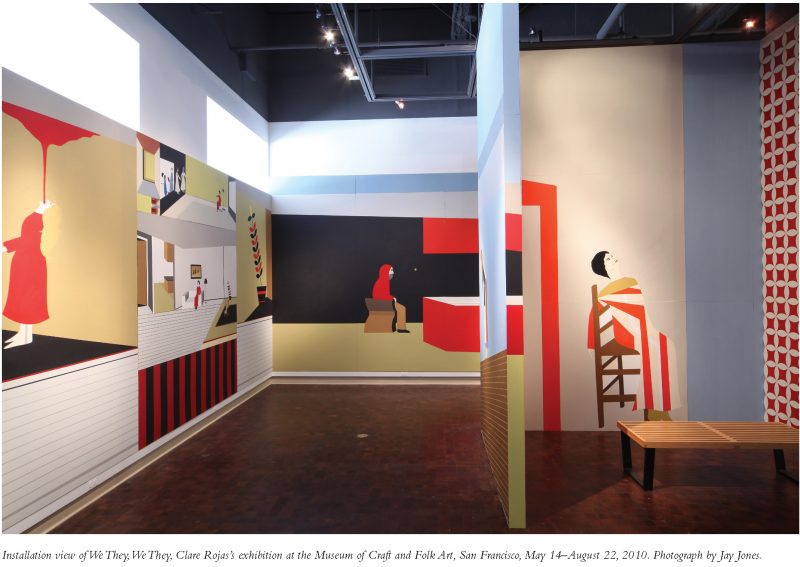Clare Rojas (b. 1976, Ohio, lives and works in San Francisco), who has produced work and exhibited internationally since the ’90s, is often placed within the context of what is considered the most definable art movement to emerge out of the Bay Area in the late twentieth century: the “San Francisco Mission School.” This core group of artists, including Barry McGee, Margaret Kilgallen, Alicia McCarthy, and Chris Johanson, was made known through exhibitions at Yerba Buena Center for the Arts and the Luggage Store in San Francisco, Alleged Gallery in New York, the documentary Beautiful Losers, and, later, through notorious shows with Deitch Projects.
Rojas uses a wide range of media, including painting, installation, and video. Her images reference high art and popular culture—West Coast modernism and Quaker art, Byzantine mosaics, Native American textiles, sign painting, and outsider art. Rojas also sings and plays guitar and banjo under the name of Peggy Honeywell. She’s produced several CDs with her own songs, including Faint Humms (2005) and Green Mountain (2006).
Clare Rojas participated in this conversation at the Museum of Craft and Folk Art on Yerba Buena Lane in San Francisco a few months ago to discuss We They, We They—Rojas’s first solo museum show in San Francisco. The standing-room-only audience gathered to see Rojas’s work and hear what the artist had to say about domestic space and the myth of the Mission School.
—Natasha Boas

I. STORYTELLING
THE BELIEVER: Your three iconic prints—the hooded man, the dark haired-woman, and the red house. Let’s begin with those.
CLARE ROJAS: I was invited as the artist-in-residence to make prints a couple of years ago, and I think that really made me remember my roots as a printmaker, as an art student at Rhode Island School of Design, and how that informs how I paint.
BLVR: People often try to find a narrative within your work. They want to piece together a story with your images. This is part of your involvement in storytelling, and the folk-art tradition. We see it with your children’s books—you create stories. I wonder if there is a specific story you are telling with these three elements.
CR: That’s interesting, because at the time I made those three prints, I started writing my novel, and I think that the writing process is a very isolating process. You have to be alone and you have to be really alone—anyway, I do—and very quiet and focused on trying to write. And before my pen could hit the paper, I had to figure out my whole story. I had to start very simply, and I realized I didn’t know...
You have reached your article limit
Sign up for a digital subscription and continue reading all new issues, plus our entire archives, for just $1.50/month.
Already a subscriber? Sign in




